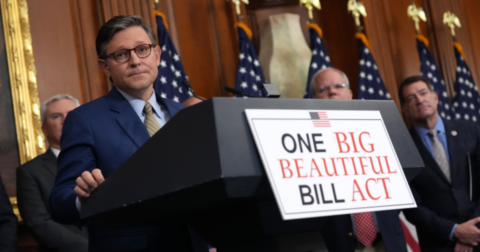News
Sentient Impact Report 2025
Policy•1 min read
News
The megabill is a “grab bag of Republican and meat and dairy industry interests,” but its fate is uncertain.


Words by Seth Millstein
The House Republicans have now passed the sweeping piece of budgetary legislation requested by President Trump. Colloquially known as the “megabill,” the legislation passed by a single vote with no Democratic support, and is primarily aimed at extending the tax cuts for wealthy Americans that Trump signed in 2017. But the megabill contains significant agriculture and food-related provisions as well, including cuts to food stamps and financial assistance to meat and dairy producers.
It’s worth noting at the top that this bill isn’t yet law, and won’t become law until the Senate passes it as well. As is usually the case with big pieces of legislation, the Senate will likely pass its own version of the bill, which will then need to be reconciled with the House bill and then passed in identical form by both chambers.
In other words, none of this is set in stone yet, and the bill will almost certainly change before becoming law. Although there are some debates within the Republican caucus over what provisions the final bill will include, the broad strokes will likely remain the same, says Andrew deCoriolis, executive director of Farm Forward.
“The bill is really a grab bag of Republican and meat and dairy industry interests,” deCoriolis tells Sentient. “The disagreement is really not whether or not we should be cutting taxes and giving tax breaks to big companies and millionaires and billionaires, but whether we should cut more social safety net programs to pay for it.”
Let’s take a look at what’s in the megabill, and how it will — and won’t — affect American farming and food systems.
The GOP’s 2024 farm bill proposal, which did not pass, included a version of the EATS Act, a highly controversial bill that would ban states from enacting laws that interfere with the interstate commerce of agricultural products.
The primary goal of the EATS Act — as well as its more-recent successor, the Food Security & Farm Protection Act — is to overturn California’s Proposition 12, which requires farmers to give egg-laying hens, pigs and veal calves a certain amount of living space in animal farms (a modest increase of space from standard factory farms). The law also requires that all eggs, pork and veal sold in the state be produced in accordance with these requirements, even if the products were produced out of state.
Republican lawmakers did insert some of the 2024 farm bill’s provisions into the megabill. But the EATS Act wasn’t one of them; the megabill contains no language that would diminish, weaken or overturn Proposition 12.
The reason for this — one of them, at least — is that Republicans in the Senate plan on passing the megabill using budget reconciliation, a legislative maneuver that allows lawmakers to circumvent any potential filibuster and pass a bill with only 51 votes. But the tradeoff is that any bill passed using budget reconciliation can only include budget-related provisions, and overturning Proposition 12 has nothing to do with federal spending. As such, it wasn’t, and couldn’t have been, included.
Because the megabill contains some components of the proposed 2024 farm bill, its successful passage could make a new farm bill an even lower priority for lawmakers than it already is. And while this is pure speculation, this could be good news for Proposition 12, as the farm bill was the primary mechanism by which Republicans were attempting to repeal the California law.
SNAP is the Supplemental Nutrition Assistance Program, otherwise known as food stamps. Around 41 million Americans receive SNAP benefits every year, which they can use to buy groceries.
The megabill cuts federal SNAP funding by around $300 million over the next decade, ostensibly by shifting some of the cost burden to states. The reason this is being characterized as a cut in funding, rather than simply a redistribution of the cost burden, is that there’s no guarantee that any state will be both willing and able to cover the difference.
Historically, the federal government has funded 100 percent of the SNAP program. The megabill breaks from this tradition by requiring states to fund at least five percent, and potentially up to 25 percent, of SNAP benefits that their residents receive. The exact percentage depends on each state’s historical “error rate,” or the frequency with which it has over- or under-paid SNAP recipients in the past.
States with higher error rates will have to shoulder a bigger share of SNAP funding. An analysis of historical error rates by Center for Budget and Policy Priorities found that, if the past is any guide, every state other than South Dakota will potentially have to fund 15 percent or more of its SNAP benefits in at least some years under the new bill.
This isn’t the only way in which the bill slashes SNAP funding. In addition to paying for the benefits themselves, the federal government also reimburses states for the cost of administering SNAP, but the megabill will reduce that funding from 50 percent to 25 percent, again shifting more costs to individual states. It also raises the age threshold of the program’s already-stringent work requirements from 54 to 64.
“It’s not subtle in what it’s doing,” deCoriolis says. “This bill seems like a massive transfer of wealth from hungry Americans and low-to-medium income Americans who rely on supplemental food programs.”
The megabill also increases subsidies for the meat and dairy industries, both of which are already heavily subsidized by the federal government.
First, it increases both the amount of money that dairy producers receive through the Dairy Margin Coverage Program and the number of producers who are eligible for the program. This is a price stabilization program aimed at protecting the economic wellbeing of the dairy industry when milk prices fall below certain levels.
“That’s a direct transfer of wealth,” deCoriolis says of the DMC expansion. “That’s a direct giveaway to dairy companies.”
Similarly, the bill raises the reference prices for the USDA’s commodity programs, which function similarly to the DMC but for things like rice and wheat instead of dairy. In effect, this means that the government will subsidize farmers of these commodities even more generously than they already do.
The bill also increases funding and eligibility for various livestock subsidy programs, which compensate livestock farmers when their animals are killed by predators or disease. As deCoriolis notes, many vertically-integrated agribusinesses produce both livestock and grains to feed the livestock, and thus stand to benefit in both cases from the megabill’s increased support levels.
“[They’ll] get subsidies on both ends of the production,” deCoriolis says. “It’s a smart way to capture even more taxpayer dollars.”
The bill eliminates most of the clean energy tax credits established by the 2022 Inflation Reduction Act (IRA), but retains and actually extends one: The 45Z tax credit. Officially known as the Clean Fuel Production Credit, it’s ostensibly aimed at providing a tax incentive for producers of clean transportation fuels; in practice, however, it’s most commonly claimed by producers of biofuels, the environmental benefits of which are highly questionable at best.
This is relevant to agriculture because biofuels are often produced using manure from factory farms, which themselves cause an enormous amount of environmental destruction in a number of different ways. As such, large industrial animal farms that produce biofuels will financially benefit from the extension of the 45Z tax credit.
“It’s just a biofuel expansion program,” deCoriolis says. “Our own investigation from earlier this year showed that a lot of the IRA money that was going to biodigesters was being used to help expand factory farms, especially in the Midwest. This bill would substantially expand the 45Z credit program, and would give it another four years of life.”
The megabill is over 1,000 pages long, and contains a number of other measures that will affect American agriculture. It increases crop insurance subsidies and tax deductions for businesses that include farms, and reduces the estate tax, which taxes the inheritance of property.
This last provision is relevant to agriculture because farms are frequently passed from generation to generation in the same family.
“You’ve got a lot of ranchers who pass on these extremely large, valuable ranches in their wills, and they don’t want to pay taxes on it,” deCoriolis says.
With all of that being said, it’s worth stressing again that this bill will almost certainly undergo changes if and before it becomes law. DeCoriolis notes that the Republican Senate caucus includes some moderate lawmakers who might object to the megabill’s spending cuts, which apply not only to SNAP but also Medicare and Medicaid.
“Those are programs that literally every American in every geography uses, [including] lots and lots of constituents in the states that are represented by Republican Senators,” deCoriolis says. “I could see them kicking a different version of the bill back to the House, and then having to have some reconciliation process between those versions of the bill.”
Ultimately, we won’t know for sure until the Senate passes its version of the bill — and given that Republicans have only a three-seat majority in that chamber, it may be quite a while until that happens.